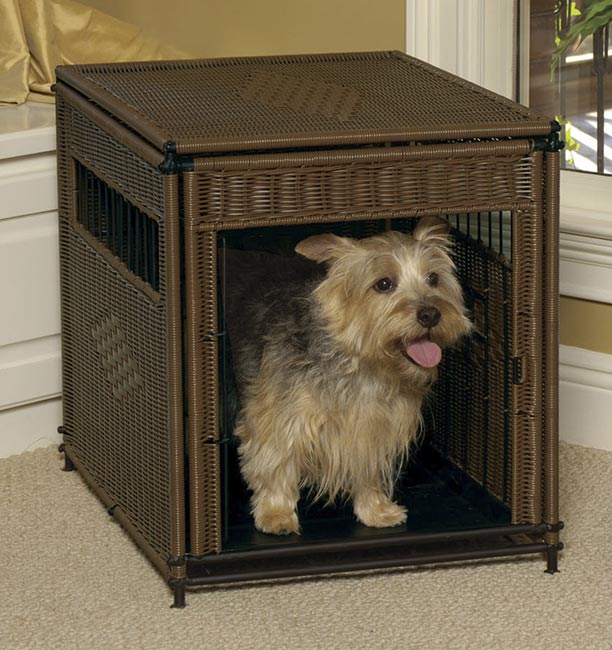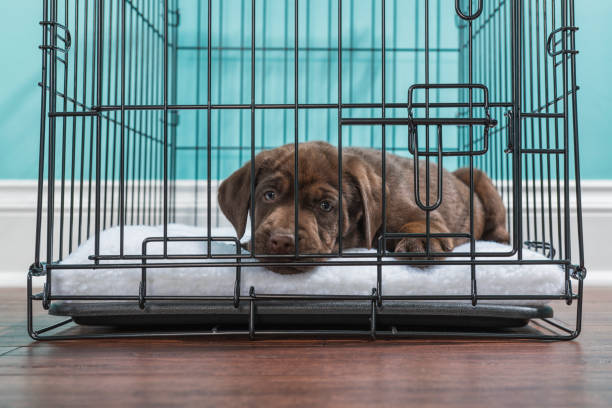Imagine a peaceful night’s sleep, with the soft sound of your dog’s rhythmic breathing lulling you into dreamland. But as a responsible dog owner, you may wonder, should you keep a dog crate in your bedroom at night? Many pet owners grapple with this question, concerned about striking the balance between fostering a sense of security for their furry companion and maintaining their own peace and tranquility. In this article, we will explore the benefits and considerations of having a dog crate in your bedroom at night, helping you make an informed decision that ensures the well-being of both you and your beloved canine companion.
Benefits of Keeping a Dog Crate in Your Bedroom
Creates a Sense of Security
One of the primary benefits of keeping a dog crate in your bedroom is that it creates a sense of security for your furry friend. Dogs are pack animals, and they naturally seek the comfort of being close to their human family members. By having their crate in your bedroom, you provide them with a safe and familiar space, keeping them close to you during the night. This can alleviate any separation anxiety they may feel and help them feel more secure and at ease.
Reduces Anxiety
Another advantage of having a dog crate in your bedroom is that it can help reduce anxiety in your four-legged companion. Dogs, especially those who have experienced trauma or have a history of anxiety, often find solace and comfort in enclosed spaces. The crate becomes a den-like environment that allows them to feel protected and secure. Being in close proximity to you while they sleep can further alleviate their anxiety, as they can sense your presence and feel reassured.
Easier Monitoring
Keeping a dog crate in your bedroom also allows for easier monitoring of your dog’s behavior and well-being during the night. If your dog is prone to restless nights, keeping them in the crate within your bedroom enables you to observe any unusual behaviors, such as excessive scratching or restlessness. It also allows you to quickly address any potential health concerns or comfort issues that may arise during the night.
Promotes Bonding
Having your dog’s crate in your bedroom promotes a stronger bond between you and your furry companion. Dogs are social animals and thrive on companionship. By having them near you while you sleep, you are fostering a deeper connection and strengthening your bond. Your dog will feel more connected to you emotionally and will know that they are an important part of your pack. This sense of closeness can lead to increased trust and overall happiness for both you and your furry friend.
Assists with Housebreaking
For puppies or dogs in the process of being housebroken, keeping their crate in your bedroom can be beneficial. Dogs have a natural instinct to keep their sleeping area clean, and by having their crate nearby at night, you can reinforce this instinct. If your dog needs to go outside to eliminate, they are more likely to signal you or wait until you let them out if they are sleeping close by. This proximity allows for quicker response times and helps expedite the housebreaking process.
Considerations for Keeping a Dog Crate in Your Bedroom
Your Sleep Quality
While keeping a dog crate in your bedroom can offer numerous benefits for your furry friend, it’s important to consider your own sleep quality as well. Some dogs may be restless during the night, causing disturbances that can disrupt your sleep. If you are an extremely light sleeper or have difficulties falling asleep, having your dog’s crate in your bedroom might not be the best option for you. Remember that a good night’s sleep is crucial for your own well-being, so prioritize your own needs when making this decision.
Noise and Disturbances
Another factor to consider when deciding whether to keep a dog crate in your bedroom is the potential for noise and disturbances. Dogs may scratch or whine if they need to go outside, or they may experience nightmares and make sudden movements or sounds. These nocturnal disruptions can interfere with your sleep and lead to fatigue or reduced sleep quality over time. Consider whether you can manage these disturbances without significant impact on your own well-being.
Allergies or Asthma
If you suffer from allergies or asthma, having a dog crate in your bedroom may exacerbate these conditions. Even though dogs are known for their shedding, keeping a clean and well-maintained living space can minimize allergies and asthma symptoms. However, having a dog crate in close proximity during the night might increase your exposure to pet dander or allergens. It’s essential to evaluate your own health conditions and consult with a healthcare professional before making a decision.
Limited Space
The availability of space in your bedroom is another essential consideration when contemplating keeping a dog crate in your bedroom. While you want to ensure your dog is comfortable and has enough room to move around, it’s crucial to assess whether your bedroom can accommodate a crate without causing congestion or hindering your own mobility. Limited space can lead to inconvenience and make it challenging to maintain a peaceful and clutter-free sleeping environment.
Alternatives to Keeping a Dog Crate in Your Bedroom
Designated Sleeping Area in Another Room
If you decide that keeping a dog crate in your bedroom is not suitable for you, a viable alternative is designating a sleeping area for your furry friend in another room. Choose a quiet and comfortable space that offers the necessary security and promotes relaxation. Ensure the room is dog-proofed and contains items such as a cozy bed or blanket, water, and toys. This alternative allows your dog to have their own space while still being relatively close to you.
Baby Gates Instead of Crate
Another alternative to a dog crate in your bedroom is to utilize baby gates to confine your dog to a specific area. This can be particularly useful if your dog is already trained and doesn’t require the added security of a crate. Set up the baby gates in a safe and spacious area, ensuring your dog has access to their bed, water, and toys. This alternative offers a sense of freedom while still providing boundaries and preventing them from roaming throughout the house unsupervised.
Dos and Don’ts for Keeping a Dog Crate in Your Bedroom
Do: Set Boundaries
When keeping a dog crate in your bedroom, it’s crucial to establish boundaries. Teach your dog that the crate is their designated sleeping area and reinforce this by setting consistent expectations. Communicate with your dog through positive reinforcement and reward them for entering the crate on their own accord. Consistency is key in ensuring your dog understands the crate as a safe and comfortable space.
Do: Make the Crate Comfortable
To promote your dog’s acceptance of the crate, make sure it is comfortable and inviting. Add soft bedding or blankets to provide them with a cozy spot to sleep. Include a few familiar toys or items that carry their scent to create a sense of familiarity and security. Remember that the crate should be a positive and comforting space for your dog, so pay attention to their preferences and adapt the crate accordingly.
Do: Gradually Transition to Another Location if Needed
If you find that keeping a dog crate in your bedroom is no longer feasible or desirable, consider gradually transitioning your dog to another sleeping location. Start by moving the crate to a nearby area, such as a hallway or another room, and gradually increase the distance over time. This gradual transition allows your dog to adjust to the change and feel comfortable in their new sleeping space. Monitor their behavior and provide reassurance and positive reinforcement throughout the process.
Don’t: Use the Crate as a Punishment
It’s crucial to avoid using the crate as a form of punishment. The crate should always be associated with positive experiences and a safe haven for your dog. Using the crate as a disciplinary measure can create negative associations and lead to your dog developing anxiety or fear towards the crate. Discipline should be handled separately from the crate, focusing on positive reinforcement and training techniques to correct unwanted behaviors.
Don’t: Encourage Dependence on the Crate
While the crate can be a valuable tool, it’s important not to encourage excessive dependence on it. Gradually increase the time your dog spends outside the crate and allow them to explore the house under supervision. Encourage independence and provide them with alternative safe spaces throughout your home. This balanced approach ensures that your dog feels secure and comfortable in various environments and situations.

Benefits of a Crate-Trained Dog
Provides a Safe Space
Having a crate-trained dog provides them with a safe and secure space they can retreat to when they need some downtime or solitude. When properly trained, the crate becomes a sanctuary where your dog feels at ease, especially when they are feeling overwhelmed or anxious. This safe space can help reduce stress and promote overall well-being for your furry companion.
Supports Training and Discipline
Crate training is an effective tool for supporting training and discipline. The crate can be used to teach your dog boundaries and reinforce positive behaviors. By using the crate as a controlled space, you can manage your dog’s behavior and prevent them from engaging in destructive or unwanted behaviors when unsupervised. Crate training also enhances your dog’s ability to understand commands and follow routines, contributing to their overall obedience and well-mannered behavior.
Helps with Traveling and Vet Visits
A crate-trained dog is generally more comfortable with travel and vet visits. The familiarity and security provided by the crate can help reduce stress and anxiety associated with these situations. When traveling, the crate serves as a safe and familiar place for your dog to rest, ensuring their comfort throughout the journey. During vet visits, a crate-trained dog is already accustomed to being in an enclosed space, making examinations and procedures less stressful for both your dog and the veterinarian.
Prevents Destructive Behaviors
Crate training is an effective way to prevent destructive behaviors in dogs, especially when they are left alone for extended periods. Dogs may chew furniture, shoes, or other household items when they are bored or anxious. By confining your dog to a crate during these times, you can prevent them from engaging in destructive behaviors and keep them safe from swallowing or chewing on hazardous objects. A crate-trained dog understands that the crate is their designated resting place and will associate it with relaxation rather than destructive tendencies.
Steps to Crate Training a Dog
Choose the Right Size and Style of Crate
To start crate training, it’s essential to choose the right size and style of crate for your dog. The crate should be spacious enough for your dog to comfortably stand up, turn around, and lie down in, but not too large that it allows for bathroom accidents. Consider your dog’s size, breed, and growth potential when selecting a crate. Opt for a crate with a secure latch and proper ventilation to ensure your dog’s safety and comfort.
Make the Crate a Positive Space
Introduce the crate as a positive and inviting space for your dog. Place soft bedding and toys inside to make it comfortable and appealing. Leave the crate door open and allow your dog to explore it at their own pace. Encourage them to enter the crate by using treats or their favorite toys, associating positive experiences with the crate. Make the crate a place of relaxation and reward your dog whenever they voluntarily enter or spend time inside.
Introduce the Dog to the Crate Gradually
Once your dog is familiar with the crate, begin the process of crate training by introducing them to the concept of being confined in the crate. Start with short periods of time, gradually increasing the duration as your dog becomes more comfortable. Use treats and positive reinforcement to encourage them to enter the crate willingly. Avoid forcing your dog into the crate or closing the door abruptly, as this may create negative associations.
Use Encouragement and Positive Reinforcement
Consistency is key when crate training your dog. Encourage them to enter the crate on their own using positive reinforcement, such as treats or verbal praise. Reward them for calm and relaxed behavior while inside the crate. Avoid yelling or scolding if your dog feels anxious or restless in the beginning stages of crate training. Patience and positive reinforcement will help your dog associate the crate with positive experiences and gradually eliminate any anxiety or resistance.
Establish a Routine for Crate Usage
To optimize the benefits of crate training, establish a routine for crate usage. Use the crate during times when your dog needs to rest or be confined, such as during bedtime or when you’re away from home temporarily. Consistency in crate usage helps your dog understand when and how long they will be inside the crate, creating a sense of predictability and security. Follow a consistent schedule and gradually increase the duration your dog spends in the crate, ensuring they still have plenty of time for exercise and socialization.
Factors to Consider for Crate Placement
Temperature and Air Circulation
When placing the crate, consider the temperature and airflow in the area. Ensure that the crate is not exposed to direct sunlight or drafts that can cause discomfort to your dog. Maintain a comfortable temperature within the room, avoiding extreme heat or cold. Proper ventilation is crucial to prevent overheating and ensure a fresh supply of air for your dog.
Accessibility and Visibility
The crate should be easily accessible for your dog to enter and exit. Avoid placing it in areas where there are obstacles or furniture that may impede your dog’s movement. Additionally, consider the visibility of the crate. Dogs often feel more at ease when they can see their surroundings. Position the crate in a way that allows your dog to have a clear view of their surroundings, reducing feelings of confinement or isolation.
Proximity to Family Activities
Placing the crate in an area where your family spends most of their time can be beneficial for your dog. Dogs are social animals and enjoy being near their human companions. Positioning the crate in a central location, such as the living room or kitchen, allows your dog to feel included in family activities while still having a designated space of their own.
Comfort and Security
Ensure that the crate is placed in a quiet and peaceful area of your home. Avoid high-traffic areas or places where there are frequent disturbances. The crate should provide a sense of comfort and security for your dog, so choose a location that allows for a serene and peaceful environment. Avoid placing the crate near sources of loud noise, such as appliances or speakers, as this can create anxiety or stress for your furry friend.
Tips for a Peaceful Night with a Crate in Your Bedroom
Establish a Nighttime Routine
Creating a nighttime routine can help your dog settle into the crate and prepare for sleep. Establish a consistent schedule for feeding, exercise, and potty breaks leading up to bedtime. As bedtime approaches, engage in calming activities such as a short walk or gentle play to help your dog relax. Following a consistent routine signals to your dog that it is time to wind down and go to sleep.
Dim Lights and Create a Calm Environment
Before bedtime, dim the lights in your bedroom to create a calm and relaxing environment. Dogs are sensitive to their surroundings, and a well-lit room may inhibit their ability to fall asleep. Close curtains or blinds to minimize external stimuli and create a dark, cozy atmosphere that promotes restful sleep.
Encourage Calm Behavior Before Bedtime
Encourage calm behavior from your dog in the hours leading up to bedtime. Avoid engaging in high-energy activities or playtime that might leave your dog feeling hyperactive or excited. Instead, focus on gentle petting, belly rubs, or brushing to help your dog relax. This calm and soothing interaction will guide your dog into a more serene state, making it easier for them to settle into their crate for the night.
Use White Noise or Soothing Music
White noise or soothing music can help drown out external noises and provide a peaceful backdrop for sleep. Consider playing soft instrumental music or using a white noise machine in your bedroom to create a relaxing ambiance. This background noise can be especially helpful if your dog is easily startled or disturbed by household sounds during the night.
Avoid Interacting with the Dog if They Whine or Bark
If your dog whines or barks during the night, it’s important to avoid direct interaction. Responding to their calls may inadvertently reinforce the behavior and encourage them to continue whining or barking. Instead, wait for a moment of silence or pause in the noise before offering any attention or reassurance. This teaches your dog that being calm and quiet leads to positive interaction, while excessive noise goes unrewarded.

Successful Coexistence with a Dog Crate in Your Bedroom
Prioritize Your Needs
When making the decision to keep a dog crate in your bedroom, it’s essential to prioritize your own needs and well-being. Evaluate whether having the crate in your bedroom aligns with your lifestyle, sleep quality, and overall comfort. While your dog’s happiness and sense of security are important, it’s crucial to strike a balance that ensures your own rest and relaxation.
Respect Your Dog’s Space
Respecting your dog’s space within the crate is crucial to their well-being. Avoid disturbing them while they are resting or seeking solitude in their crate. Honor their need for a safe and secure environment, and refrain from invading their personal space unless it is necessary for their care or well-being.
Adapt and Adjust as Needed
Every dog is unique, and their needs may change over time. Stay attentive to your dog’s behavior and adjust their crate placement or usage accordingly. If you notice signs of discomfort or restlessness, consider revising their sleeping arrangement or introducing alternative measures to meet their needs. Flexibility and adaptability are key to ensuring a harmonious coexistence with a dog crate in your bedroom.
Monitor Your Dog’s Behavior and Health
Regularly monitor your dog’s behavior, mood, and overall health to ensure that the presence of the crate in your bedroom continues to be beneficial. Keep an eye out for any signs of stress, anxiety, or physical discomfort that may arise from the sleeping arrangement. Regular vet check-ups and open communication with professionals can provide valuable insights into your dog’s well-being and any necessary adjustments to their sleeping arrangements.
Enjoy the Benefits of Having Your Dog Nearby at Night
Having your dog nearby at night offers numerous benefits for both you and your furry companion. The increased sense of security, bonding, and assistance with housebreaking can contribute to a more enjoyable and harmonious relationship. Enjoy the unique connection and comfort that comes with having your dog crate in your bedroom, appreciating the positive impact it has on your lives.
Conclusion
Deciding whether to keep a dog crate in your bedroom at night involves careful consideration of several factors. While there are clear benefits to having your dog nearby, such as increased security, reduced anxiety, and improved bonding, it’s crucial to also prioritize your own sleep quality and health. Evaluating factors such as noise, allergies, space availability, and personal preferences will help guide your decision-making process. Regardless of your choice, proper crate training and considering alternatives can ensure your dog’s well-being and your own comfort. Ultimately, it’s about finding the balance that works best for you and your furry friend, fostering a healthy and loving relationship.


